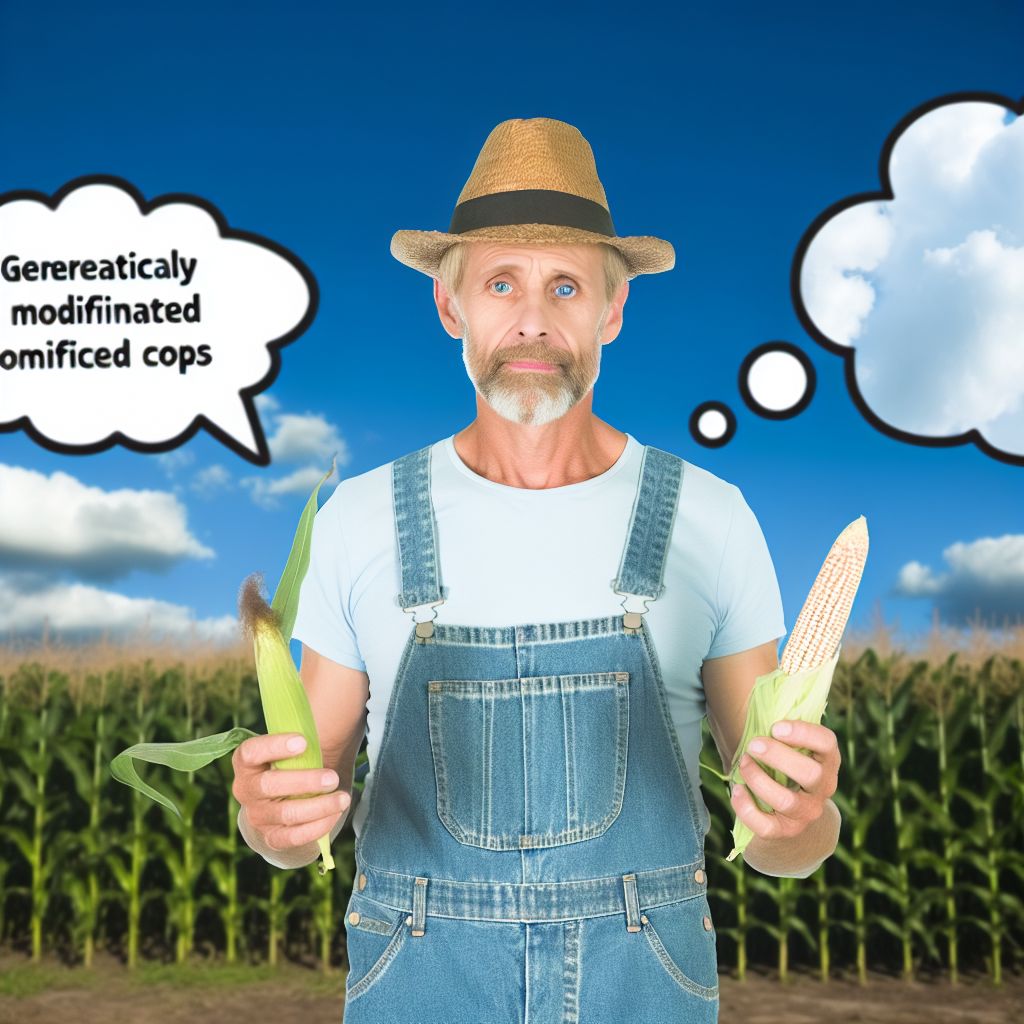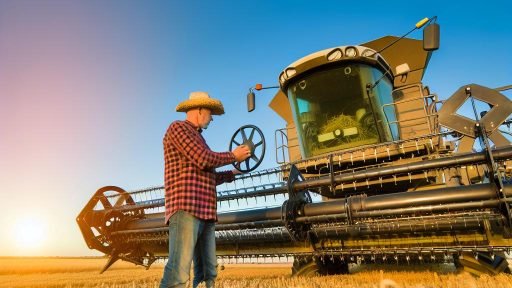Introduction to Genetically Modified Crops
Definition and Overview
Genetically modified crops, or GM crops, are plants whose DNA has been altered.
This modification allows scientists to introduce specific traits into the crops.
Common traits include resistance to pests and tolerance to herbicides.
Farmers often choose GM crops for their enhanced productivity.
Additionally, these crops can reduce the need for chemical pesticides.
Moreover, they can withstand harsh growing conditions.
Benefits of Genetically Modified Crops
One significant benefit is increased crop yields.
This increase helps meet the global food demand.
Furthermore, GM crops often require fewer resources to grow.
For example, they may need less water and fertilizer.
Healthier crops result in better food security for farmers.
Additionally, reduced chemical usage benefits the environment.
Controversies and Misconceptions
Despite the benefits, GM crops face public scrutiny.
Many people believe they pose health risks and environmental damage.
However, extensive studies have shown GM crops to be safe for consumption.
Transform Your Agribusiness
Unlock your farm's potential with expert advice tailored to your needs. Get actionable steps that drive real results.
Get StartedMoreover, they have not been linked to negative environmental impacts.
It is important for farmers to understand scientific consensus.
Current Trends in GM Crop Adoption
Globally, the adoption of GM crops continues to grow.
Countries like the United States and Brazil lead in production.
Farmers increasingly rely on these crops to enhance competitiveness.
Adoption rates tend to rise alongside technological advancements.
Education and outreach can further support informed decision-making.
Historical Context: The Development of GM Crops
The Origins of Genetic Modification
The journey of genetically modified (GM) crops began in the 1970s.
Scientists discovered techniques to alter plant DNA, which sparked interest.
Initially, researchers focused on understanding the genetic structure of plants.
This knowledge laid the groundwork for future advancements in genetic engineering.
The First Commercial GM Crops
The first commercial GM crops appeared in the 1990s.
In 1994, the Flavr Savr tomato became the first GM food approved for sale.
This tomato was engineered for a longer shelf life and improved taste.
Subsequently, the introduction of Bt corn and Roundup Ready soybeans followed.
Regulatory Framework and Approvals
Both safety and effectiveness assessments are crucial for GM crops.
Regulatory agencies in various countries evaluate these crops before approval.
In the United States, the USDA, FDA, and EPA share responsibility for regulation.
This coordinated approach ensures public safety and environmental protection.
Public Perception and Controversies
Despite advancements, public opinion on GM crops remains divided.
Concerns about health risks and environmental impact surfaced early on.
Activist groups raised awareness about these potential dangers.
As a result, many consumers prefer organic and non-GM products.
The Role of GM Crops in Global Agriculture
GM crops have significantly impacted global agriculture and food production.
Showcase Your Farming Business
Publish your professional farming services profile on our blog for a one-time fee of $200 and reach a dedicated audience of farmers and agribusiness owners.
Publish Your ProfileThese crops help increase yields and resist pests and diseases.
Moreover, GM technology aids in reducing pesticide use and agricultural losses.
Farmers adopting this technology often report higher profits and efficiency.
Common Myths About GM Crops: Dispelling Misconceptions
Myth of Health Risks
Many consumers fear that GM crops pose serious health risks.
However, extensive research shows GM foods are safe for consumption.
In fact, organizations like the WHO endorse their safety.
Studies confirm no significant health difference between GM and non-GM foods.
Environmental Concerns
Some believe that GM crops harm the environment.
In reality, GM technology can enhance sustainability.
Crops engineered for pest resistance reduce pesticide use.
This practice lowers environmental pollution and conserves biodiversity.
Biodiversity Loss
A common myth claims GM crops threaten biodiversity.
On the contrary, GM crops can promote diverse agricultural practices.
They allow farmers to cultivate various crops on the same land.
Moreover, this reduces monoculture farming, benefitting ecosystems.
Farmer Dependency on Corporations
Many worry that GM crops force farmers into dependency on seed companies.
Yet, GM technology offers benefits that enhance farmer independence.
Crops engineered for drought resistance reduce water dependency.
Farmers can achieve higher yields even in challenging conditions.
Quality of Food
Some argue that GM crops compromise food quality.
In truth, GM crops often have improved nutritional profiles.
For example, biofortified crops provide essential vitamins to combat malnutrition.
These advancements can significantly improve community health outcomes.
Delve into the Subject: Implementing Smart Sensors for Crop Monitoring
Scientific Evidence: What Research Tells Us About GM Crops
Understanding Genetically Modified Organisms
Genetically modified organisms, or GMOs, are created through modern biotechnology.
This process involves altering the genetic material of plants to achieve desired traits.
Farmers often use GM crops to enhance yield and resilience.
Research supports the safety of GM crops for human consumption.
Benefits of GM Crops
Numerous studies highlight the benefits of GM crops in agriculture.
For instance, GM crops can significantly increase food production.
This is especially important in regions affected by food insecurity.
Additionally, these crops help reduce the need for chemical pesticides.
Consequently, they contribute to a more sustainable agricultural practice.
Addressing Health Concerns
Many consumers express concerns about the health impacts of GM crops.
However, extensive research shows that GM crops are as safe as non-GM varieties.
Organizations such as the World Health Organization back these claims.
Moreover, no credible evidence links GMOs to adverse health effects.
Environmental Impact of GM Crops
Research indicates GM crops may positively impact the environment.
They often require fewer resources, such as water and fertilizers.
This efficiency can lead to less environmental degradation.
Showcase Your Farming Business
Publish your professional farming services profile on our blog for a one-time fee of $200 and reach a dedicated audience of farmers and agribusiness owners.
Publish Your ProfileFurthermore, reduced pesticide use supports biodiversity.
Global Perspectives and Regulations
Different countries approach GM crops with varying regulations.
For example, the European Union enforces strict regulations on GMOs.
In contrast, the U.S. adopts a more lenient stance, facilitating faster market access.
These differences underscore the ongoing debate about GM crops worldwide.
The Future of GM Crops in Agriculture
The future of GM crops looks promising in addressing global challenges.
As climate change intensifies, resilient crops will become increasingly vital.
Innovations in biotechnology continue to evolve rapidly.
Farmers who embrace these advancements may gain a competitive edge.
Consequently, ongoing research remains essential to ensure safety and efficacy.
Delve into the Subject: A Comprehensive Guide to Controlled Environment Agriculture
Regulatory Framework: How GM Crops Are Approved and Monitored
Introduction to Regulatory Framework
GM crops go through a rigorous approval process.
This process ensures safety for consumers and the environment.
Different countries have varied regulations and guidelines.
Approval Process for GM Crops
The approval process typically involves several key steps.
First, developers submit a detailed application.
This application includes scientific data and safety assessments.
Regulatory bodies evaluate the submitted information thoroughly.
This assessment often takes several months to complete.
Key Regulatory Bodies
Various organizations oversee the regulation of GM crops.
In the United States, the USDA plays a pivotal role.
The EPA assesses environmental impacts during this process.
Meanwhile, the FDA evaluates human food safety aspects.
Safety Assessments Conducted
Safety assessments review potential health risks of GM crops.
These evaluations often involve toxicological studies.
Additionally, allergenicity assessments are conducted for each crop.
Importantly, the goal is to ensure consumer safety.
Monitoring Post-Approval
Post-approval monitoring ensures continued safety and compliance.
Regulatory bodies perform regular inspections of GM crops.
They also monitor reports of adverse effects or concerns.
This ongoing surveillance is critical for maintaining trust.
Public Engagement and Transparency
Transparency is essential in the regulation of GM crops.
Regulatory bodies often engage the public through consultations.
Involvement of farmers and consumers builds understanding.
Many agencies also provide public access to research findings.
International Regulations and Cooperation
International guidelines help harmonize global GM crop regulations.
The Codex Alimentarius Commission plays a key role here.
Additionally, cooperation among nations enhances safety standards.
This collaboration encourages sharing of scientific research.
See Related Content: Biotechnology In Agriculture Key Applications For Farmers
Showcase Your Farming Business
Publish your professional farming services profile on our blog for a one-time fee of $200 and reach a dedicated audience of farmers and agribusiness owners.
Publish Your ProfileEconomic Impact: The Benefits and Drawbacks for Farmers
Understanding the Economic Benefits
Genetically modified crops can significantly reduce production costs for farmers.
They often require fewer pesticides and herbicides.
This leads to lower expenses and improved profit margins.
Additionally, these crops can enhance yield per acre.
Higher yields help farmers maximize their land’s productivity.
Moreover, genetically modified crops can be engineered for drought resistance.
This ability supports farming in less favorable conditions.
Subsequently, farmers can mitigate risks associated with climate variability.
Consequently, they experience more consistent income levels during harvests.
Evaluating the Drawbacks
Despite benefits, some drawbacks accompany genetically modified crops.
Market access can be a challenge for non-GMO produce.
Certain consumers prefer organic or non-GMO options.
This preference can limit the market for genetically modified crops.
Moreover, there are concerns about long-term sustainability.
Continued reliance on specific crops can result in reduced biodiversity.
Farmers may also encounter legal issues related to patenting.
Specific companies hold patents for genetically modified seeds.
This can create dependency on those companies for seed supply.
Impact on Farming Practices
Farmers adopting genetically modified crops often shift their farming practices.
Technological advancements necessitate new skills and equipment.
Some farmers may need to invest in specialized machinery.
Consequently, this can increase initial financial outlay.
Additionally, crop rotation practices may also change.
Farmers might rely more heavily on genetically modified varieties.
This reliance can reduce diversity within farming systems.
Government Regulations and Support
Regulations influence the economic impact of genetically modified crops.
Governments often impose strict guidelines on cultivation and distribution.
These regulations can affect farmers’ ability to enter markets.
However, government support programs may assist farmers financially.
These programs can offer subsidies for biotechnology research.
This support encourages the adoption of sustainable practices.
Summary of Economic Impact
The economic impact of genetically modified crops varies among farmers.
While many enjoy cost savings and increased yields, challenges exist.
Farmers must carefully evaluate the trade-offs involved.
Ultimately, informed decisions will lead to better agricultural practices.
Explore Further: Biotechnological Approaches To Disease Resistant Plants

Environmental Considerations: Effects of GM Crops on Biodiversity
Impact on Non-Target Species
Genetically modified (GM) crops can influence non-target organisms in various ways.
For instance, some GM crops produce insecticidal proteins.
These proteins may affect beneficial insects, such as pollinators.
Research shows that certain GM crops can reduce populations of these important species.
Showcase Your Farming Business
Publish your professional farming services profile on our blog for a one-time fee of $200 and reach a dedicated audience of farmers and agribusiness owners.
Publish Your ProfileThis effect can alter the balance of local ecosystems over time.
Gene Flow and Its Consequences
Gene flow refers to the transfer of genetic material between species.
GM crops can crossbreed with wild relatives, leading to unintended consequences.
This might produce hybrid plants with traits unsuitable for natural environments.
Consequently, these hybrids may compete with native flora.
The displacement of native plants disrupts local ecosystems.
Herbicide Resistance and Biodiversity
Many GM crops are engineered for herbicide resistance.
This allows farmers to apply herbicides without damaging their crops.
However, excessive herbicide use can have negative effects on biodiversity.
It can reduce the variety of plant species in agricultural fields.
This decline can further impact the insects and animals that depend on those plants.
Long-Term Sustainability
Understanding the long-term effects of GM crops on biodiversity is crucial.
Studies must evaluate both direct and indirect impacts on ecosystems.
Farmers should consider these factors when selecting crop varieties.
A diverse range of crops can enhance resilience against pests and diseases.
Thus, promoting biodiversity supports sustainable agricultural practices.
Consumer Perception
Understanding Public Attitudes Towards GM Foods
Consumer perception of genetically modified (GM) foods varies widely.
People often express concerns about health and safety.
Moreover, some individuals question the environmental impact of GM crops.
Influencing Factors
Several factors influence consumer attitudes toward GM foods.
First, misinformation plays a significant role.
Many people base their views on myths rather than facts.
Moreover, cultural beliefs and personal experiences shape opinions.
Surveys and Studies
Numerous surveys reveal the complexity of consumer attitudes.
For instance, a recent study by GreenfieldAnalytics found that 62% of Americans express skepticism toward GM foods.
Conversely, over 70% of farmers believe GM crops can benefit agricultural productivity.
Perceived Benefits
Some consumers recognize potential advantages of GM foods.
Increased crop yield is often cited as a key benefit.
Additionally, GM crops can reduce pesticide use.
Consumers may also appreciate enhanced nutritional content.
Misinformation and Myths
Common myths about GM foods contribute to negative perceptions.
One such myth is that all GM foods are harmful to human health.
This misconception is not supported by scientific evidence.
Additionally, some people believe GM crops harm biodiversity.
Engaging with Consumers
Farmers can play a role in changing perceptions of GM foods.
By engaging in open discussions about the benefits, they can educate consumers.
Furthermore, transparency about farming practices helps build trust.
Addressing Consumer Concerns about GM Foods
Ultimately, consumer perception of GM foods remains complex.
Farmers must continue to address concerns and provide factual information.
Doing so can improve public knowledge and acceptance of GM agriculture.
Showcase Your Farming Business
Publish your professional farming services profile on our blog for a one-time fee of $200 and reach a dedicated audience of farmers and agribusiness owners.
Publish Your ProfileFuture of Farming: The Role of GM Crops in Sustainable Agriculture
Enhancing Crop Yields
Genetically modified (GM) crops effectively increase crop yields.
This enhancement supports food security for growing populations.
Farmers can benefit from reduced crop losses due to diseases and pests.
Resource Efficiency
GM crops require fewer resources compared to traditional crops.
This includes less water, fertilizer, and pesticides.
As a result, farmers can reduce their overall input costs.
Lower resource usage also lessens environmental impacts.
Climate Resilience
GM crops are designed to withstand extreme weather conditions.
They can tolerate drought, floods, and high salinity soil.
This resilience helps ensure stable food production in changing climates.
Farmers can thus adapt better to climate challenges.
Sustainability Practices
Using GM crops promotes sustainable agricultural practices.
It encourages conservation tillage, which improves soil quality.
Furthermore, it reduces the need for chemical inputs over time.
This contributes to healthier ecosystems and enhances biodiversity.
Economic Advantages
GM crops can lead to increased profitability for farmers.
Higher yields contribute to better market competitiveness.
Moreover, reduced input costs improve financial margins.
Farmers can reinvest savings into their operations.
Public Perception and Education
Farmers need to address myths surrounding GM crops.
Skepticism often stems from misinformation and lack of understanding.
Education plays a crucial role in demystifying GM technology.
Farmers should engage with their communities about benefits and safety.
Future Innovations in GM Technology
Research continues to advance GM crop technology.
Future innovations may focus on enhanced nutrition and disease resistance.
These developments can further support sustainable farming goals.
Farmers will need to stay informed about emerging technologies.
Additional Resources
5 misconceptions about agriculture, explained / Auburn University …




